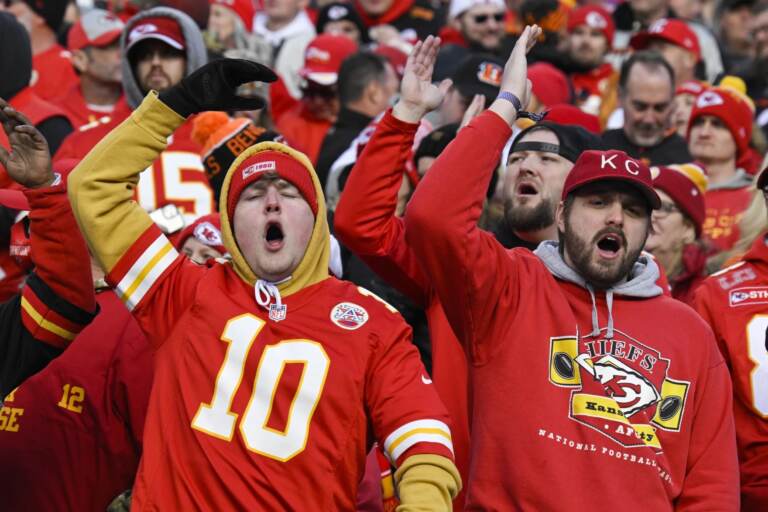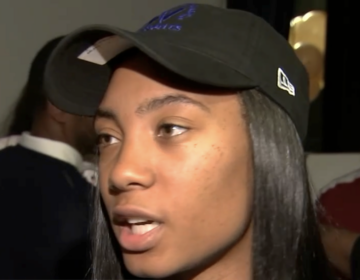As Kansas City Chiefs head to the Super Bowl, their violent traditions alienate even some local fans

Kansas City Chiefs fans at Arrowhead Stadium do the "tomahawk chop" during the second half of the 2022 AFC Championship football game against the Cincinnati Bengals. (Reed Hoffman/AP)
The Kansas City Chiefs’ unprecedented success has made them the darling of the National Football League. Their high-flying quarterback, Patrick Mahomes, has attracted new fans from around the world, and local businesses benefit from the millions of dollars spent by spectators reveling in the team’s success.
But, as the city at-large celebrates their third Super Bowl appearance in four seasons, many fans feel conflicted. Some feel outright alienated every time they see that arrowhead-shaped logo or the so-called “tomahawk chop.”
“Our people were rounded up, kids stolen from their families, sent to boarding schools … and stripped of their culture and identity,” said Rhonda LeValdo, a Haskell Indian Nations University professor, Acoma Pueblo activist and founder of the Not In Our Honor coalition.
“Their religion was outlawed, they could not practice their ceremonies, they couldn’t sing their songs,” LeValdo said. “So why is it OK for the fans in Kansas City to play Indian, when our people weren’t allowed to be Indian?”
LeValdo’s coalition has protested the team’s use of Native American imagery and traditions since 2005, but she’s been on the front lines of Native activism for decades.
LeValdo thinks the team’s behavior is a mockery of Native culture, and said it harms mental health.
Scientific research backs her up: The American Psychological Association said in a 2005 report that “a growing body of social science literature shows the harmful effects of racial stereotyping and inaccurate racial portrayals, including the particularly harmful effects of American Indian sports mascots on the social identity development and self-esteem of American Indian young people.”
LeValdo, who is a fan of the Kansas City Royals and the Kansas Jayhawks, said she also wants to be a fan of pro football in Kansas City, but team traditions like the banging of a ceremonial drum before the game make it impossible.
“Your drums are important pieces to your tribe. Anytime you have a powwow there is no alcohol allowed,” LeValdo said, noting how freely the beer flows in the stands at Arrowhead. “You don’t do that. That’s sacrilege.”
The NFL’s diversity problem
For podcast creator Mat Hofstetler, watching the 2020 Super Bowl with a group of friends who weren’t Chiefs fans became an awkward affair because of fans’ penchant for doing the tomahawk chop.
“There was just a noticeable uncomfortableness after that first touchdown that Patrick Mahomes ran in,” he said. “You can see the fans doing that chop in the background, and you hear that chant coming through.”
“I think this current team is way too exciting for the Kansas City community to (have to) feel embarrassed about it,” Hofstetler said.
Hofstetler, who grew up in Kansas, created the podcast “Sometimes It Rains” to explore the intersection of sports and social justice. He now lives in New York, and considers himself a lifelong fan of Kansas City football.
His problems with the League go beyond Native team names and imagery. He says diversity among ownership — in a league whose players are 75% African American — is a problem.
“Especially Black ownership, but really (there’s) no minority ownership whatsoever in the NFL,” Hofstetler said.
Efforts to diversify management have fallen short, he said, including the 20-year-old “Rooney Rule,” which requires all NFL teams interview at least one minority candidate before filling an open coaching job.
“I know the Rooney Rule had the best of intentions, but I think we’re seeing that it’s yielding all kinds of problems, in that it’s essentially a checkmark, so to speak, that doesn’t really require you to give any actual attention or intent to hiring Black coaches,” he said. “I think that’s a huge problem.”
The rule hasn’t resulted in a head coaching position for Chiefs offensive coordinator Eric Bienemy, who is Black, despite the fact he is one of the best assistant coaches in the League.
‘Taking full ownership and responsibility’
Dr. Justin Chandler is a neurovascular neurologist at Centerpoint Medical Center in Independence, and a die-hard Chiefs fan.
As a former high school football player, he understands the benefits the sport can bring, including a boost in character development and better teamwork skills.
As a doctor who studies brain health, he also knows the sport can lead to repeated brain trauma.
“You can get really bad sheer injuries when (that happens, and) that can cause permanent neurological deficits,” he said.
And the big, dramatic hits that many fans relate to concussions aren’t what worry him most.
“The accumulation of the small ones over time ends up leading to our chronic traumatic encephalopathy,” he said.
Traumatic brain injuries have been a stain on the NFL since at least 2005, and the release of the movie “Concussion.” The film documented the League’s cover-up of CTE, a degenerative condition that can only be detected in the brain after someone has died
“It ends up leading to our memory problems, and it ends up leading to different psychiatric manifestations of concussions over time as well,” Chandler said. “A big part of that is depression, increased aggression — all of these systems are affected within the brain.”
A 2017 study at Boston University showed 99% of all former players whose brains were tested after death showed signs of the disease.
That list of 111 athletes includes Hall of Famers Junior Seau and Mike Webster.
Former Chiefs linebacker Jovan Belcher is also on that list. On Dec. 1, 2012, Belcher killed his girlfriend Kasandra Perkins at their home, then drove to the team’s practice facility where he shot himself in the head.
An attorney involved in subsequent lawsuits against the Chiefs claimed the team knew Belcher and his significant other were having major domestic violence issues, and that he had a major concussion two weeks prior.
Chandler acknowledged the NFL has made great strides on brain health over the past decade, but he knows they can do better.
“I think the league comes out and they say, ‘This is our No. 1 priority,’ and then … they put their money where their mouth is,” he said. “I think that they (need to) dump as much as they can into technology, into research, into rehabilitation.”
“Taking full ownership and responsibility of the risk is something that society will also respond to. … It also addresses the moral complexity of watching somebody go out there and take a hit for your entertainment,” Chandler said.
9(MDAzMzI1ODY3MDEyMzkzOTE3NjIxNDg3MQ001))




